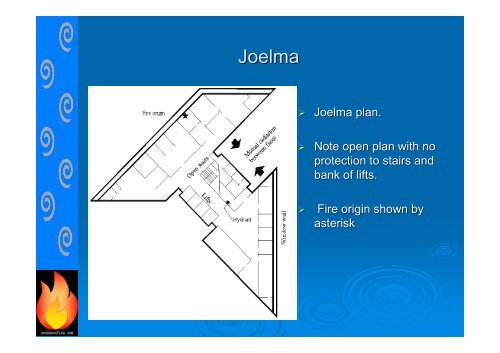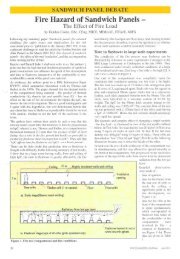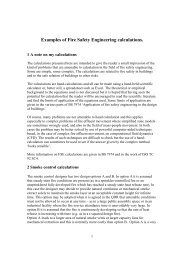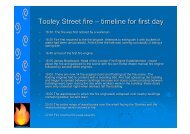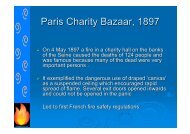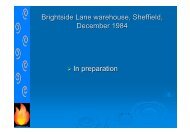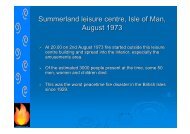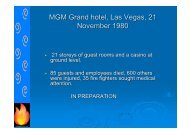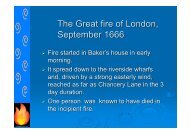Joelma high-rise, Sao Paulo, 1974
Joelma high-rise, Sao Paulo, 1974
Joelma high-rise, Sao Paulo, 1974
You also want an ePaper? Increase the reach of your titles
YUMPU automatically turns print PDFs into web optimized ePapers that Google loves.
<strong>Joelma</strong>‣ <strong>Joelma</strong> plan.‣ Note open plan with noprotection to stairs andbank of lifts.‣ Fire origin shown byasterisk
<strong>Joelma</strong> – the building‣ The beams, columns and floor slabs were of reinforcedconcrete with a floor-toto-floor height of 2.6 m.‣ .‣ Plan shape featured two oddly-shaped office wings joined by acentral services core comprising a single staircase and bank offour passenger lifts which ran the full height of building.‣ The service core was not separated from the officeaccommodation by partitions.‣ Roofs were covered with corrugated asbestos sheeting andhad parapet walls only 0.3 m <strong>high</strong>.‣ Windows were of 6 mm glass in aluminium frames and hadopenable portions.
<strong>Joelma</strong> – the building‣ Office areas had partitions which were of timber.‣ Suspended ceilings were of 20 mm combustible fibre tiles onwood strips.‣ There was no emergency lighting, no manual or automaticalarms, no automatic detection and no automatic firesuppression system.‣ There was one 64 mm diameter rising main with 38mm hosein cabinets at each floor level.‣ Water storage for this main was in a tank on the roof and thesupply make-up was pumped from the basement by electricmotor.
<strong>Joelma</strong> fire
<strong>Joelma</strong> fire
<strong>Joelma</strong> fire
<strong>Joelma</strong> – balcony protection‣ <strong>Joelma</strong> 3 hours after firestarted.‣ Many people still waitingto be rescued, protectedby the building balconyprojections
<strong>Joelma</strong>‣ Many people rescuedfrom <strong>high</strong> positions byturntable ladders
<strong>Joelma</strong> – rooftop refugeSome ofthose whoreached theroof diedthere orjumped.Survivorswere takenoff byhelicopter
<strong>Joelma</strong> - observations‣ Fire started due to an electrical fault caused by lack of a circuit breaker‣ Whereas the concrete structure was demonstrably fire resisting, the interiorfinishes (partitions and ceilings) were entirely of combustible materials andthis encouraged rapid fire spread‣ Only one stairway was provided and it was not enclosed – smoke and firecould and did spread internally from storey to storey‣ There was no fire separation between the two office wings‣ There were no local evacuation alarms, no exit signs, and no emergencyprocedures for occupants‣ The lifts were used intelligently and they stopped only at wanted d floors.Luckily the power supply to the lifts was not affected early on and some 300people were evacuated by lift‣ Downdraft from helicopter rotors was said by some survivors to be a help tosurvival for those taking refuge on the roof.
<strong>Joelma</strong> - observations‣ Some occupants, aware of the successful helicopter rescue from the tAndraus building fire two years before, moved up to the roof, but t there wasno wind to deflect the plume of smoke and hot air and helicopters s could notreach many on the roof top in time. The UK policy is to discourage the useof helicopters in this way.‣ A decree in 1963 and its related code recommended that there should befire-proof and smoke-proof escape stairways separated from the mainbuilding by a 250 mm thick wall with non-combustible doors to each story,but this had not been complied with.‣ Research by BRE concluded a) that a 2 ft horizontal projection between bwindows in vertically-adjacent adjacent storeys is inadequate to prevent flames froma fire entering the upper storey unless fire-resisting resisting glazing is used, and b)that the only sure way to prevent external fire spread would be to omit allwindows from the storey immediately above the one with windows.‣ If combustible interiors are present and there are unprotected shafts s(e.g.open stairs and lifts) the building should be retrofitted with an automaticsprinkler system


